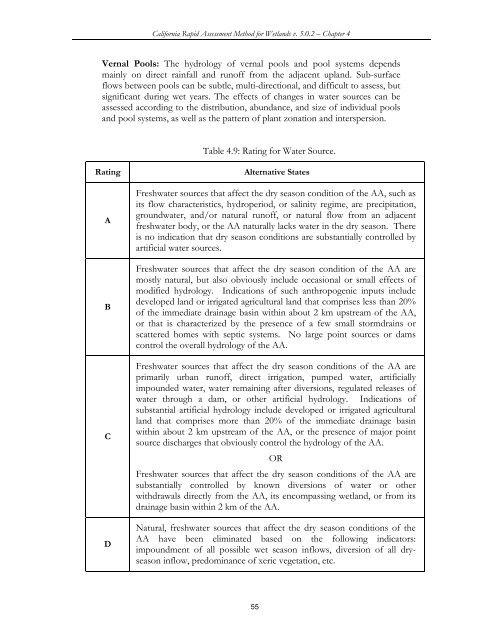(CRAM) For Wetlands User's Manual Version 5.0.2
(CRAM) For Wetlands User's Manual Version 5.0.2
(CRAM) For Wetlands User's Manual Version 5.0.2
You also want an ePaper? Increase the reach of your titles
YUMPU automatically turns print PDFs into web optimized ePapers that Google loves.
California Rapid Assessment Method for <strong>Wetlands</strong> v. <strong>5.0.2</strong> – Chapter 4<br />
Vernal Pools: The hydrology of vernal pools and pool systems depends<br />
mainly on direct rainfall and runoff from the adjacent upland. Sub-surface<br />
flows between pools can be subtle, multi-directional, and difficult to assess, but<br />
significant during wet years. The effects of changes in water sources can be<br />
assessed according to the distribution, abundance, and size of individual pools<br />
and pool systems, as well as the pattern of plant zonation and interspersion.<br />
Table 4.9: Rating for Water Source.<br />
Rating Alternative States<br />
A<br />
B<br />
C<br />
D<br />
Freshwater sources that affect the dry season condition of the AA, such as<br />
its flow characteristics, hydroperiod, or salinity regime, are precipitation,<br />
groundwater, and/or natural runoff, or natural flow from an adjacent<br />
freshwater body, or the AA naturally lacks water in the dry season. There<br />
is no indication that dry season conditions are substantially controlled by<br />
artificial water sources.<br />
Freshwater sources that affect the dry season condition of the AA are<br />
mostly natural, but also obviously include occasional or small effects of<br />
modified hydrology. Indications of such anthropogenic inputs include<br />
developed land or irrigated agricultural land that comprises less than 20%<br />
of the immediate drainage basin within about 2 km upstream of the AA,<br />
or that is characterized by the presence of a few small stormdrains or<br />
scattered homes with septic systems. No large point sources or dams<br />
control the overall hydrology of the AA.<br />
Freshwater sources that affect the dry season conditions of the AA are<br />
primarily urban runoff, direct irrigation, pumped water, artificially<br />
impounded water, water remaining after diversions, regulated releases of<br />
water through a dam, or other artificial hydrology. Indications of<br />
substantial artificial hydrology include developed or irrigated agricultural<br />
land that comprises more than 20% of the immediate drainage basin<br />
within about 2 km upstream of the AA, or the presence of major point<br />
source discharges that obviously control the hydrology of the AA.<br />
OR<br />
Freshwater sources that affect the dry season conditions of the AA are<br />
substantially controlled by known diversions of water or other<br />
withdrawals directly from the AA, its encompassing wetland, or from its<br />
drainage basin within 2 km of the AA.<br />
Natural, freshwater sources that affect the dry season conditions of the<br />
AA have been eliminated based on the following indicators:<br />
impoundment of all possible wet season inflows, diversion of all dryseason<br />
inflow, predominance of xeric vegetation, etc.<br />
55















